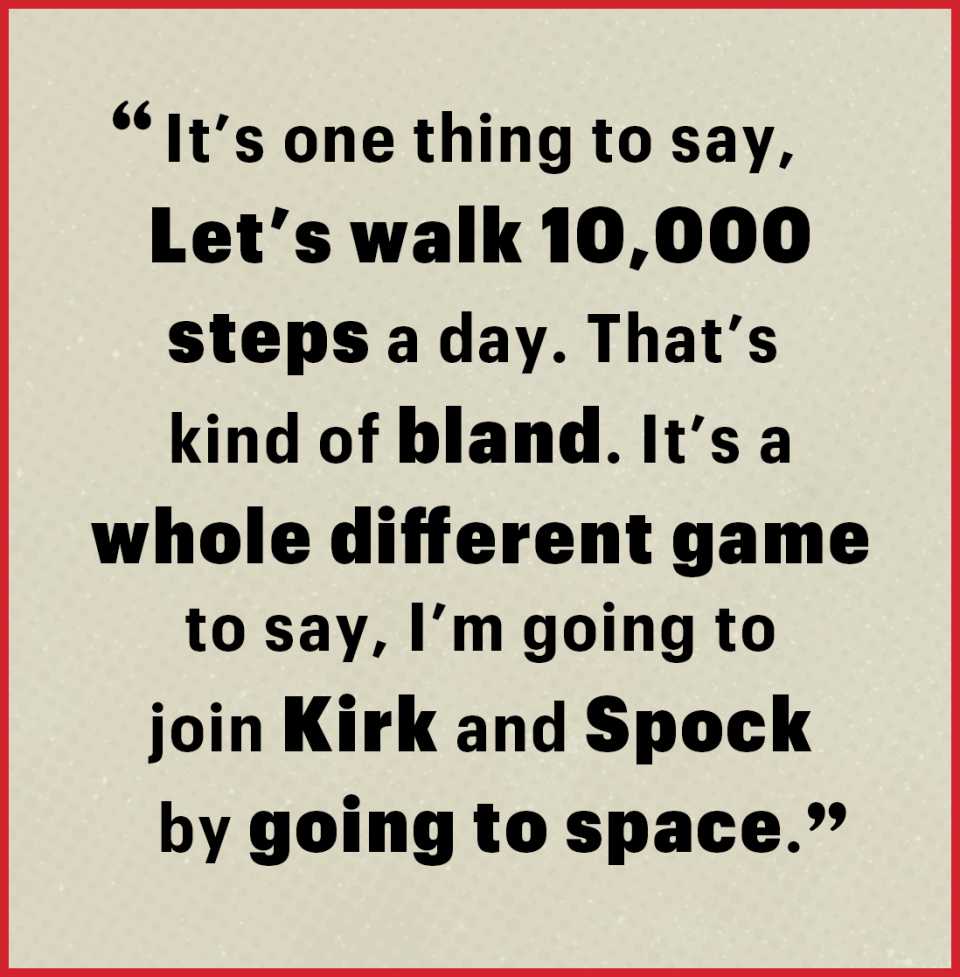The Life-Changing Power of Chasing Absurd Fitness Goals

I’M NOT A BILLIONAIRE and can’t afford my own phallic rocket, but I’ve always wanted to go to space. So I’ve decided to walk there. That’s been my 2022 fitness goal: walk to space. Or at least the vertical equivalent of space. I’m more than halfway there, and I have no plans to stop.
To back up: For the past few years, I’ve been dutifully notching the traditional 10,000 steps per day. It seemed a reasonable goal and has been moderately motivating. I live in New York City, and I do a lot of my errands on foot. I also have a treadmill desk, and I write my emails while huffing along, so I usually reach my 10K a couple hours before bedtime.
But after so many years, 10,000 steps was getting kind of monotonous. Well-trodden ground, so to speak.
In early January, I noticed that the display panel on my treadmill tracks not just horizontal mileage but also vertical distance. I walk at an 11 percent incline, so after 45 minutes, I’d climbed 300 feet, the rough height of the Statue of Liberty.
It sparked a thought: If I kept climbing, how high could I get? I could probably do 1,000 feet—about one Eiffel Tower—a day. If I kept going for a few weeks, eventually I’d summit the Alps. And by the end of the year, I could really get some altitude. I looked it up, and outer space begins 328,084 feet above sea level, the so-called Kármán line. I could take a gentle ramp to the exosphere! Watch your back, Branson and Bezos.
Since I like accountability, I decided to announce my goal. I posted about my “Walk to Space” quest on Facebook. The post got tons of reactions—encouragement, awe, mockery. But the best part was that several dozen people wanted to join me on the Spacewalk.
Next thing I knew, we had an official Facebook page with more than 40 Spacewalkers from all over the United States (and a few in Canada and Chile), some of whom I knew but most of whom were friends of friends. Some were traveling on a treadmill like I was, but others were heading to space by stairs (including a teacher who lives in a five-story walk-up in Manhattan). Some were doing it all outdoors, like a Boulder-based artist who is trudging up steep Colorado trails.
Soon my fellow Spacewalkers had created spreadsheets. One artist designed a Spacewalkers logo based on the Space Force emblem. We traded tips on the best ways to track altitude. Some used an app called Strava, others the Apple Health app; still others were Fitbit fans. In fact, we discovered that Fitbit has its own version of Spacewalking, awarding badges to inspire users. There’s a Skydiver badge for those who have climbed 500 floors and a Shooting Star badge for those who have climbed 14,000, among others.
“I’m really psyched to have a new metric to track and a new, creative goal to work toward,” wrote a personal trainer from Oregon.
Todd, an airline pilot in Philadelphia, said he thought it was fun. “I’ve wanted to go to space my whole life.”
“I just passed Angel Falls!” a man from California told me.
Of course, not everyone was drawn to the stars. My wife wished me luck but said she’d stick to more earthbound workouts.

But for many of my acquaintances, the Spacewalk really struck a chord. I wondered why. Why do we find it more motivating than the 10,000 steps a day? That milestone, incidentally, is certainly popular but doesn’t have a lot of scientific backing. According to a Harvard Medical School study, the 10,000-steps-a-day metric started as a marketing gimmick for a Japanese pedometer in the 1960s. The study also showed that even 7,500 steps a day provides about the same benefits in terms of lengthening life.
I called licensed psychologist Adam Dorsay, Psy.D., the host of the SuperPsyched podcast and an expert on resilience and motivation, to get some insight.
“We are meaning-based creatures,” Dorsay told me. “It’s one thing to say, Let’s walk 10,000 steps a day. That’s kind of bland. It’s a whole different game to say, I’m going to join Kirk and Spock by going to space. Suddenly, your motivation changes.”
A big, crazy, novel goal can be supremely motivating, at least for some personality types. Just ask Andy van Bergen. Van Bergen is an Australia-based entrepreneur who, ten years ago, founded a worldwide movement called Everesting.
Everesting—it’s a verb—consists of riding a bicycle the equivalent height of Mount Everest, 29,029 feet, without stopping. For instance, you can bike a 3,000-foot hill ten times in a row. Van Bergen came up with the idea because he wanted something that his non-biking friends could understand was an impressive feat.
“When I used to tell them that I biked 6,000 meters uphill this weekend, they’d say, ‘Great, what else did you do?’ ” So he hit upon Everest as a graspable symbol and, better yet, one that caused disbelief.
“When you’re told you can’t do something, that it’s impossible, for some of us, that’s like the red rag to a bull,” he said. “I love setting out to achieve something that’s not doable tomorrow or the next day. Anything in life that is rewarding you have to work for.”
When I called van Bergen, he told me walking to space was “insane,” which was high praise from him. For the record, space is the equivalent of 11.3 Everests—though, of course, there’s a big difference between our two goals. Spacewalkers aren’t doing it in a weekend. We’re taking a year.
Or sometimes more than a year. Some Spacewalkers are on a leisurely pace. It’s not a race. It’s a supportive group.
We trade tips on how to rack up those precious inches however we can. When you climb a stepladder to change a light bulb, that could count! One guy has a driveway that slopes upward, giving him hundreds of extra feet each day.
We talk about our challenges, from injuries to Covid breaks to just plain sore legs. We do go in for the gentle mocking—ahem, “hello, way down below!”—and like to boast about our skymarks (vertical landmarks), whether it’s the height at which a stork flies, a weather balloon’s altitude, or 111 Eiffel Towers.
Not too long ago, I reached 165,000 feet, slightly past the official halfway point. To celebrate, I had a glass of orange Tang. (It’s still available!)
It looks like it’s going to take a bit longer than a year, maybe a year and a half, but I plan to hit that Kármán line. And I plan to say in my deepest baritone (which isn’t too deep), “One bazillion small steps for man, one giant leap for fitness motivation.”
After which: Mars, here I come!
Try These Extreme Challenges
Walking to space and Everesting aren’t the only virtual goals out there. Infuse your fitness with long-term fun by taking on one of these:
TANK CURLING
Big Number: 135,200 pounds
Can your guns handle the military’s M1 Abrams tank? Chase this goal with a pair of 20-pound dumbbells. If you do 4 sets of 10 curls per arm daily, you’ll take the challenge down in 85 days. Curl 4 times a week to finish in 5½ months—or twice a week to finish in under a year.
AIRPLANE PRESSING
Big Number: 404,600 pounds
Yes, your chest is powerful enough to press the weight of a Boeing 747. To finish in less than a year, train twice a week, with 4 sets of 8 reps of 135 pounds to start each workout. You’ll cover 4,320 pounds in each session to finish in 47 weeks. Rest at least 2 days between sessions; your shoulders will thank you.
MISSISSIPPI MASTERY
Big Number: 2,350 miles
Get comfy on your cardio row; you’ll need 3,781,958 meters to cover the length of the Mississippi River. If you row 4,000 meters a day (which should take about 20 minutes), you’ll finish in 2 years and 216 days. Those strokes build posture-honing back strength and glutes, too. —Ebenezer Samuel, C.S.C.S.
A version of this article originally appeared in the December 2022 issue of Men's Health.
You Might Also Like

